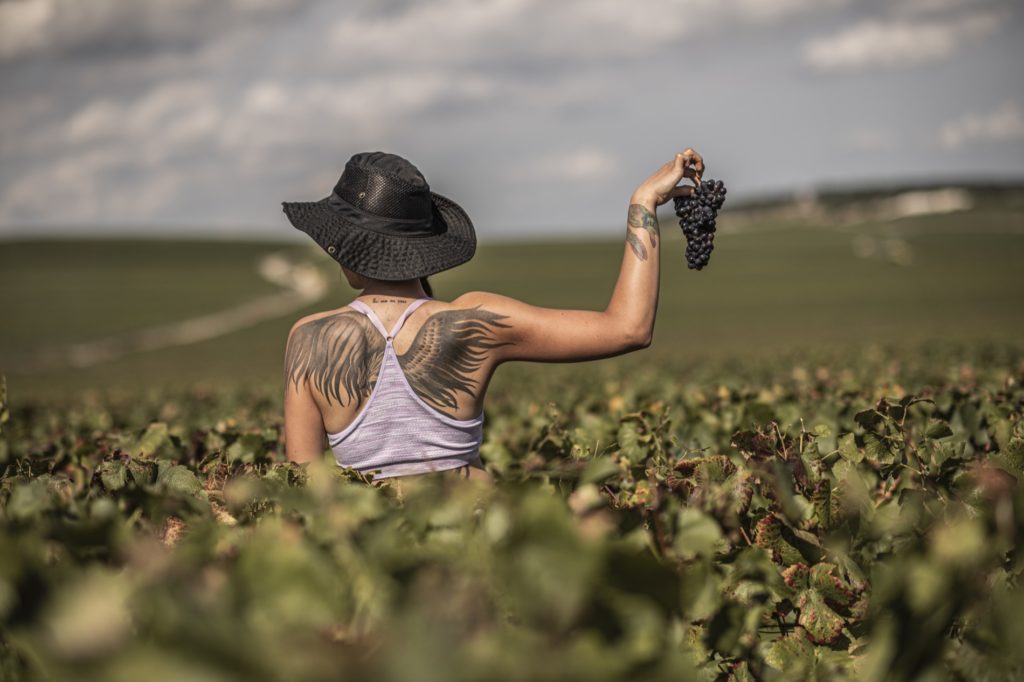Taittinger Vineyard Manager Christelle Rinville recounts a highly-eventful 2023 harvest. [read the full champagne story]
Estimated reading time: 5 minutes

Every year is a new adventure in the vineyards; constantly reminding us not only to remain humble in the face of nature but also just how precious the experience and day-to-day work of the teams in the vines truly is.

CLIMATOLOGY AND VINE BEHAVIOUR IN 2023
“After a very dry 2022 and a late winter recharge, the water balance for 2023 was starting off on an uneven footing, depending on the soil, says Christelle Rinville. However, early Spring rainfall (March and April well above seasonal normals) and summer rainfall (July and August also above normals) were particularly beneficial and have put the vines into a strong vegetative dynamic; this will be reflected in July-August by a very sharp increase in berry weight.”
Based on a technical report by Christelle Rinville, vineyard director at Taittinger, we give you our observations of the highly unusual 2023 viticultural campaign.
CLIMATOLOGY AND VINE BEHAVIOUR IN 2023
“After a very dry 2022 and a late winter recharge, the water balance for 2023 was starting off on an uneven footing, depending on the soil, says Christelle Rinville. However, early Spring rainfall (March and April well above seasonal normals) and summer rainfall (July and August also above normals) were particularly beneficial and have put the vines into a strong vegetative dynamic; this will be reflected in July-August by a very sharp increase in berry weight.”
On the whole, Chardonnays have developed serenely and steadily while the aromatic shift (fruit aromas at the expense of vegetal aromas) was very quickly noticeable, especially for the Pinot Noir and Meunier.
Despite the sharp rise in temperatures during the first decade of harvests, there has been no significant rebound on the kinetics of the potential alcohol accumulation (the berries’ sugar content).
The choice of picking date was, therefore, crucial to allow the sugars to concentrate in the later sections without compromising on health quality (development of grey rot).
In that respect, the warm and sunny conditions of the harvest were in our favour. In fact, the weather was dry overall. The first week of this harvest was marked by extreme heat and scorching hot afternoons, which meant we had to adapt our picking times.
“The surprisingly heavy weight of the bunches is something we will remember, while the number of bunches per vine was somewhat moderate and lower than the previous year. That will not have been without impact on the berries’ sugar accumulation.”
The amount of bunches damaged by grey rot was very low to non-existent in the Chardonnays; low in the later Pinots and higher in the Meuniers or earlier sections.
“Our teams raised awareness, trained, supported and supervised the picking teams to ensure the bunches to be picked were sorted perfectly (sorting based on health or level of veraison in the bunches). Everyone played a major role in ensuring the optimal quality of our harvest.”
From the 8th and 10th September 2023, activity in our press rooms has been intense and steady; the work of the teams (pressers, tank-room operators, press loaders, weighers) is coordinated and precise, to ensure the high-quality and precise composition of the lots, the final casting of an expert eye over the grapes before loading, the respectful pressing of the marc and the attention paid to the musts before transportation in tanks to the Clostermann production facility.
‘We can’t wait to taste the clear wines from this slightly puzzling year!’
concludes Christelle Rinville
See the photo report of the 2023 harvest with photos by © Anne-Emmanuelle Thion











